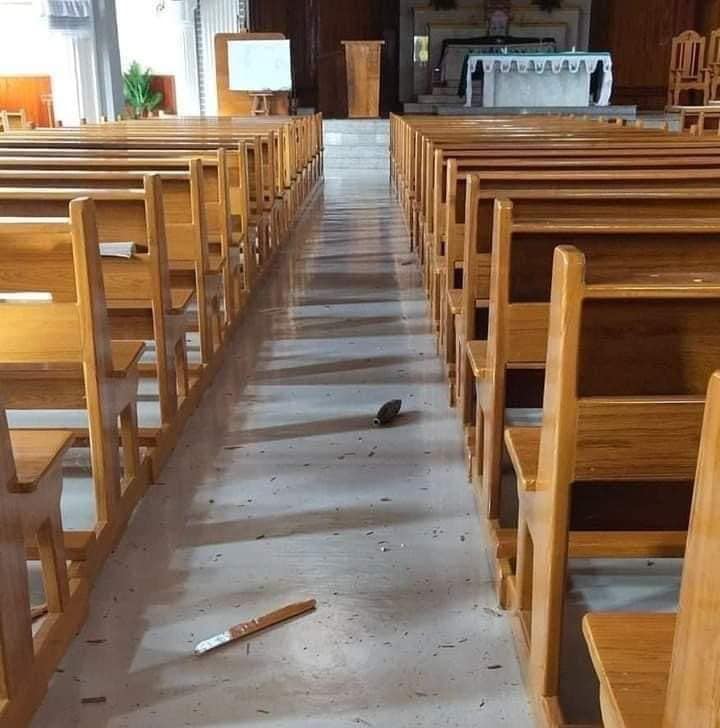As the familiar sound of bullets ricocheting off walls reverberated through the largely empty town of Pekon on Tuesday night, soldiers once again readied themselves to launch mortar shells at the grand Catholic church in the town centre.
“The church in the city had been hit by artillery three times, but this time it was very bad,” said a local bishop, adding that, on this latest occasion, two or three pieces of ordnance had landed inside the place of worship, mercifully failing to detonate. “My church was also hit by artillery, but luckily there was not much damage.”
The bishop was one of few people in Pekon left to observe the desecration; after a week of chaos had engulfed the lakeside town on the Shan-Kayah border, most residents had chosen to flee.
Pekon, on the road to both the revolutionary hotbed of Demoso and the Kayah capital of Loikaw, has been ravaged by Tatmadaw troops for the past ten days.
Last weekend, amidst reports that over 100 junta soldiers had been killed by resistance forces in the township over just two days of fighting, violence reached a bloody new peak; Since Monday, an estimated 10,000 newly displaced have added to the 8,000 already choosing to escape the sporadic military violence. Pekon has now joined the list of Burma’s virtual ghost towns—to the military, it is ripe for destruction.
A spokesperson from the Moe Bye Rescue Team, an aid group from the adjoining township, told DVB that, on Tuesday night, troops had fired barrages of heavy artillery at Pekon—with some rockets reaching as far as Moe Bye itself. Panic, and an exodus, ensued.
“A house in Moe Bye was hit by the shelling, but a significant number of homes, and a church, were hit in Pekon,” he said. “At the moment, we cannot contact the Pekon Rescue Team because the phone lines have been cut—many people fled, but currently we can’t gauge the exact number of the refugees.”
Fighting in the area began on November 1, when a coalition force consisting of the Karenni Army (KA) and the Karenni National Defense Force (KNDF) attacked a military camp in the Thuli Bela area of Demoso. Eight junta soldiers were killed during the fighting.
The following day, a battery of 200 soldiers launched a retaliatory offensive on Pekon’s Khaung Ei village. However, four coalition forces— the KA, KNDF, Pekon PDF and Moe Bye PDF—were there to meet them. Five more soldiers were killed in the fighting, in addition to two from the KNDF.
“Fighting then erupted for seven days. By Tuesday night, troops had begun firing heavy artillery” said a spokesperson of the Karenni Nationalities Defense Force-KNDF Information Team.
“During the preceding seven days, all of the nearby villages and a town had to be evacuated. The exact number is not yet known, but more than 10,000 people have fled,” he told DVB.
In the days immediately after November 1, two more SAC soldiers were killed and several others were injured when PDF groups attacked Loi Hwe village. In the early morning hours of November 3, the military returned to hunt the PDFs, and to raze the homes of the village. In nearby Khaung Ei, home to another military camp, a seven hour battle between the military and the Karenni Alliance left one KA fighter dead, several more injured, and yet more villagers displaced by violence.
On November 6, yet another clash occurred between the junta council and the Karenni coalition in Thulwe Bela village, Demoso. Following this, the coalition force launched an ambitious attack on the Tatmadaw’s LIB 421 (based in Pekon), killing three soldiers. In the days that followed, infuriated troops razed homes in Latu village and began a heavy assault on Pekon town.
A bishop from Pekon’s Loi Hwe told DVB that the area is now desolate: from the villages of the township, only 15 people remain.
“Most of the people in nearby villages in my area fled and left their homes because they were afraid of the shelling. There was intense fighting near us, and heavy artillery fell on houses. Almost everyone in the neighborhood is running away, and now the area is quiet,” he said.
“I have chosen to stay because my responsibilities lie with the church. I remain here, praying.”
The three-hour battles now common in Pekon are the most intense the town has even seen, the bishop says. Those who have chosen to stay have barricaded themselves indoors, fearful of the noise of the military’s guns.



